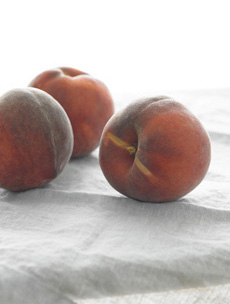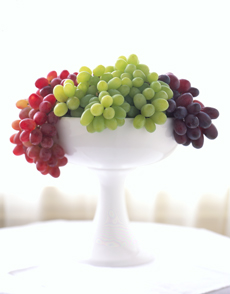TIP OF THE DAY: Storing Fresh Fruit, Part 2
|
Yesterday we featured Part 1 of How To Store Fresh Fruit. Continuing in alphabetical order, here are: GRAPES Grapes continue to ripen after picking, and can be refrigerated to slow the ripening process. You can determine freshness by examining the stems. Fresh grapes will have green and pliable stems, while grapes that have been stored for a while will have twiggy and woody ones. KIWI Keep kiwifruit at room temperature until ripe. Once ripe, kiwi will keep in the fridge for a few days. Very firm unripe kiwi will keep refrigerated for up to two months. MANGOES Mangoes can be stored at room temperature and will continue to ripen. When they give slightly to touch, they are ready to eat. They can be refrigerated to slow down the ripening process. |
Grapes look great in a pedestal bowl. Photo courtesy California Grape Commission. |
|
|
MELONS Store melons at room temperature until ripe. The FruitGuys say that the best indicator of ripeness is aroma: If a melon’s sweet fragrance is noticeable, it’s probably ready to cut and eat. In our own experience, we may not get the aroma but the outside of the melon gives slightly to pressure, particularly on the end where the stem was. If the melon feels rock-hard, give it a little more time. The exception is watermelon: A ripe watermelon has a yellow or light-colored bottom. If it’s covered with stripes, it’s not yet ready. NECTARINES Nectarines are climacteric, which means that they ripen after picking. They should be stored at room temperature, away from sunlight and heat, until they give softly to touch and have a sweet aroma. Ripening can be hastened by placing the fruit in a paper bag on the counter. When they’ve reached the desired ripeness, they can be refrigerated for several days. |
||
 Perfect peaches. Photo courtesy Washington State Fruit Commission. |
PASSION FRUIT Passion fruit is a fragrant fruit. You can tell a passion fruit is ripe when it begins to look shriveled. For the best flavor, store it on the counter out of direct sunlight and give it a few days to “wrinkle-up.” PEACHES Like nectarines, peaches are climacteric: They ripen after picking. They should be stored at room temperature, away from sunlight and heat, until they give softly to the touch and have a sweet aroma. Ripening can be hastened by placing them in a paper bag on the counter. You can refrigerate peaches, but cold temperatures may change their texture and taste. PEARS Pears are picked hard to avoid bruising and should be stored at room temperature, away from heat and sunlight. They ripen from the inside out, so when they give to the touch, particularly near the stem end, they are ready to eat. |
|
|
PLUMS, PLUOTS & APRIUMS
Both pluots and apriums are plum-apricot crosses. Like nectarines and peaches, plums continue to ripen after picking. They should be stored at room temperature, away from sunlight and heat, until they give softly to the touch and have a sweet aroma. Once ripe, refrigeration is necessary to prevent spoiling, but cold temperatures may change their texture and taste. Now that you know how to store it, it’s time to buy some fresh fruit…and enjoy it three times a day.
|
||



